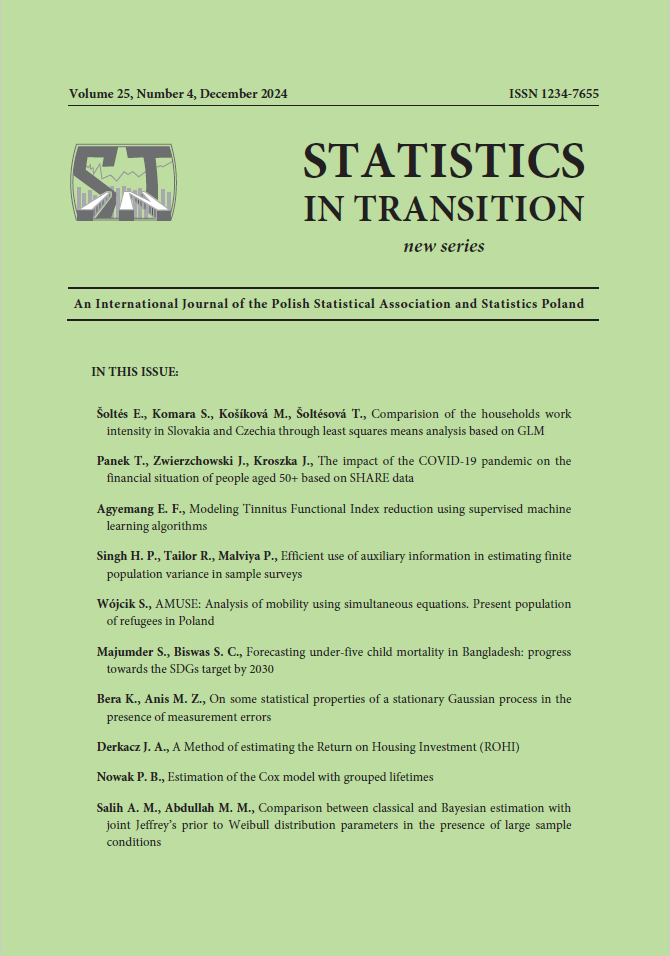ARTICLE
ABSTRACT
This study aims to model the reduction in the Tinnitus Functional Index (TFI) utilizing supervised machine learning algorithms, focusing primarily on Ordinary Least Squares (OLS), K-Nearest Neighbor (KNN), Ridge, and Lasso regressions. Our analysis highlighted Group, ISI, and SWLS as significant predictors of TFI reduction, identified through the best subset selection and confirmed by both forward and backward selection criteria in the OLS regression. Notably, the shrinkage methods, Ridge and Lasso regressions, demonstrated superior performance compared to OLS and KNN, with the Ridge regression presenting the smallest test mean square error (MSE) of 318.30. This finding establishes the Ridge regression as the best model for analyzing our Tinnitus dataset relative to the other methods, which exhibited test MSEs of 319.28 (Lasso), 330.76 (OLS), and 584.92 (KNN), respectively. This research highlights the potential of supervised machine learning algorithms in advancing personalized Tinnitus treatment, reflecting broader trends in the field as evidenced by studies in the literature. By leveraging these algorithms, we can enhance treatment precision and outcomes, contributing significantly to improved quality of life for individuals with Tinnitus. Future research should explore the integration of multimodal data and longitudinal applications of these algorithms to further refine predictive capabilities and treatment effectiveness.
KEYWORDS
Tinnitus, K-Nearest Neighbor regression, Ridge regression, Lasso regression, multiple linear regression
REFERENCES
Agbota, L., Agyemang, E., Kissi-Appiah, P., Moshood, L., Osei-Nkwantabisa, A., Agbenyeavu, V., Nsiah, A., and Adjei, A. (2024). Enhancing tumor classification through machine learning algorithms for breast cancer diagnosis. Computer Engineering and Intelligent Systems, 15(1), p. 71.
Biswas, R., Genitsaridi, E., Trpchevska, N., Lugo, A., Schlee, W., Cederroth, C. R., Gallus, S., and Hall, D. A., (2023). Low evidence for tinnitus risk factors: A systematic review and meta-analysis. Journal of the Association for Research in Otolaryngology, 24(1), pp. 81–94.
Cardon, E., Jacquemin, L., Schecklmann, M., Langguth, B., Mertens, G., Vanderveken, O. M., Lammers, M., Van de Heyning, P., Van Rompaey, V., and Gilles, A., (2022). Random forest classification to predict response to high-definition transcranial direct current stimulation for tinnitus relief: A preliminary feasibility study. Ear and Hearing, 43(6), p. 1816.
De Ridder, D., Schlee, W., Vanneste, S., Londero, A., Weisz, N., Kleinjung, T., Shekhawat, G. S., Elgoyhen, A. B., Song, J.-J., Andersson, G., et al., (2021). Tinnitus and tinnitus disorder: Theoretical and operational definitions (an international multidisciplinary proposal). Progress in brain research, 260, pp. 1–25.
Doborjeh, M., Liu, X., Doborjeh, Z., Shen, Y., Searchfield, G., Sanders, P., Wang, G. Y., Sumich, A., and Yan, W. Q., (2023). Prediction of tinnitus treatment outcomes based on eeg sensors and tfi score using deep learning. Sensors, 23(2), p. 902.
Eggermont, J. J., Roberts, L. E., (2004). The neuroscience of tinnitus. Trends in neurosci-ences, 27(11), pp. 676–682.
Gasparre, D., Pepe, I., Laera, D., Abbatantuono, C., De Caro, M. F., Taurino, A., D’Erasmo, D., Fanizzi, P., Antonucci, L. A., Pantaleo, A., et al., (2023). Cognitive functioning and psychosomatic syndromes in a subjective tinnitus sample. Frontiers in Psychology, 14.
Kutner, M. H., Nachtsheim, C. J., Neter, J., and Li, W., (2005). Applied linear statistical models. McGraw-hill.
Langguth, B., Kreuzer, P. M., Kleinjung, T., and De Ridder, D., (2013). Tinnitus: causes and clinical management. The Lancet Neurology, 12(9), pp. 920–930.
Manta, O., Sarafidis, M., Schlee, W., Mazurek, B., Matsopoulos, G. K., and Koutsouris, D. D., (2023). Development of machine-learning models for tinnitus-related distress classification using wavelet-transformed auditory evoked potential signals and clinical data. Journal of Clinical Medicine, 12(11), p. 3843.
McCormack, A., Edmondson-Jones, M., Somerset, S., and Hall, D., (2016). A systematic review of the reporting of tinnitus prevalence and severity. Hearing research, 337, pp. 70–79.
Mohan, A., Leong, S. L., De Ridder, D., and Vanneste, S., (2022). Symptom dimensions to address heterogeneity in tinnitus. Neuroscience & Biobehavioral Reviews, 134, p 104542.
Omer, P. A., (2022). Improving prediction accuracy of lasso and ridge regression as an alternative to ls regression to identify variable selection problems. Zanco Journal of Pure and Applied Sciences, 34(s6), pp. 33–45.
Rodrigo, H., Beukes, E. W., Andersson, G., and Manchaiah, V., (2021). Exploratory data mining techniques (decision tree models) for examining the impact of internet-based cognitive behavioral therapy for tinnitus: Machine learning approach. Journal of Medical Internet Research, 23(11), e28999.
Runciman, L., Johnson, C., (2023). Young adults’ knowledge and perceptions of permanent noise-induced tinnitus and its influence on behavioural intentions. Noise and Health, 25(119), pp. 236–246.
Saleh, A. M. E., Norouzirad, M., (2018). On shrinkage estimation: Non-orthogonal case. Statistics, Optimization & Information Computing, 6(3), pp. 427–451.
Smith, S. S., Kitterick, P. T., Scutt, P., Baguley, D. M., and Pierzycki, R. H., (2021). An exploration of psychological symptom-based phenotyping of adult cochlear implant users with and without tinnitus using a machine learning approach. Progress in Brain Research, 260, pp. 283–300.
Torres-Reyna, O., (2007). Linear regression using stata. Princeton University. New Jersey: Princeton University.
Tuepker, A., Elnitsky, C., Newell, S., Zaugg, T., and Henry, J. A., (2018). A qualitative study of implementation and adaptations to progressive tinnitus management (ptm) delivery. PLoS One, 13(5), e0196105.
Van den Berge, M. J., Free, R. H., Arnold, R., De Kleine, E., Hofman, R., Van Dijk, J. M. C., and Van Dijk, P., (2017). Cluster analysis to identify possible subgroups in tinnitus patients. Frontiers in neurology, 8, p. 115.
Wakabayashi, S., Oishi, N., Shinden, S., and Ogawa, K., (2020). Factor analysis and evaluation of each item of the tinnitus handicap inventory. Head & face medicine, 16, pp. 1–9.
